|
F
I S H I N G N E T S
Please use our
A-Z to
navigate this site or return HOME

MIDWATER
TRAWL - In midwater trawling a cone-shaped net is towed behind a single boat and spread by trawl doors (image), or it can be towed behind two boats (pair trawling) which act as the spreading device. Midwater trawling is relatively benign compared to the damage bottom trawling can inflict on the sea bottom.
THE
GUARDIAN 25
NOVEMBER 2017 - NORTH ATLANTIC'S GREATEST SURVIVORS HUNTED
AGAIN
One of the more hopeful ecological stories of recent years – the slow restoration of numbers of the North Atlantic
right whale – has taken a disastrous turn for the worse. Marine biologists have found their population has plunged abruptly in the past few years and that there may now only be around 100 reproductively mature females left in the sea. Many scientists fear the species could soon become the first great whale to become extinct in modern times.
The principal cause for the North Atlantic right whale’s precipitous decline has been the use of increasingly heavy commercial fishing gear dropped on to the sea bed to catch lobsters, snow crabs and hogfish off the east coast of North America. Whales swim into the rope lines attached to these sea-bed traps and their buoys and become entangled. In some cases hundreds of metres of heavy rope, tied to traps weighing more than 60kg, have been found wrapped around whales. “We have records of animals carrying these huge loads – which they cannot shake off – for months and months,” said Julie van der Hoop, of Aarhus University in Denmark.
“In some cases they have to burn more than 25,000 calories a day to carry these great weights around with them. Some whales die. In other cases, rescue workers have been able to free them but the whales are often left very thin and undernourished. As a result, they cannot reproduce.”
The North Atlantic right whale, Eubalaena glacialis, derives its name from the fact that early whalers considered them to be the “right” whales to hunt – they are slow swimmers, linger in coastal waters and float after being killed. Vast numbers were slaughtered across the Atlantic, with only a few pods surviving along the east coast of the United States and Canada. Numbers dropped – possibly to a population as low as 100 – until in 1935 it was declared illegal to hunt them.
For the rest of the 20th century their numbers increased, although at a very slow rate. By 2000 it was thought that there were about 400 right whales in the North Atlantic. This still left the species endangered but it was hoped that a continued rise in numbers would eventually take them out of danger of extinction.
However, figures presented at a meeting of the Society of Marine Mammalogy held in Halifax, Canada, last month have dashed those hopes. Delegates heard that about 50 right whales a year were now becoming trapped in
fishing gear
and that death rates due to entanglement have more than doubled over the past 10 years.
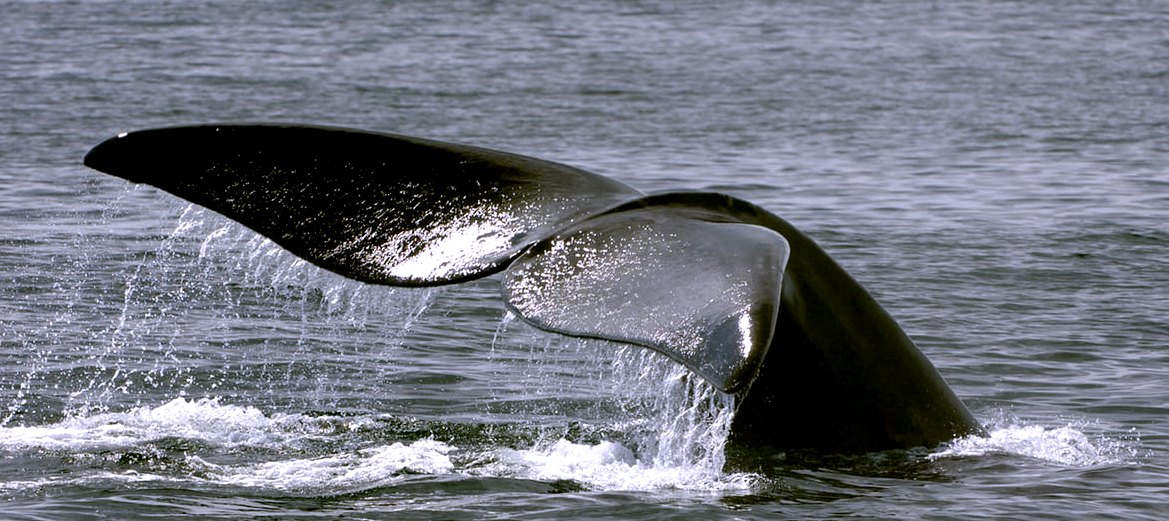
This year turns out to have been catastrophic for right whale losses,” said Ann Pabst, of the University of North Carolina Wilmington. “We know of at least 16 right whales that have died, some of which displayed evidence of ship strike and some with evidence of entanglement, and there could be more that we haven’t found about yet.”
An example of the tribulations suffered by right whales is provided by the story of Ruffian, a 13-year-old male who was discovered entangled in 138 metres of rope and a 61kg snow crab trap, which he had dragged from
Canada to Florida over a period of several months. He was eventually freed by rescue workers from the Georgia Department of Natural Resources. “I am surprised Ruffian survived given the calories he had lost in dragging around that weight,” said van der Hoop.
Other right whales have not been so lucky and many have died. In other cases, females have been left dangerously undernourished and unable to reproduce. This last point is stressed by van der Hoop. “The problem facing the North
Atlantic right whale is not just one of losses of lives but of a general loss of fertility.”
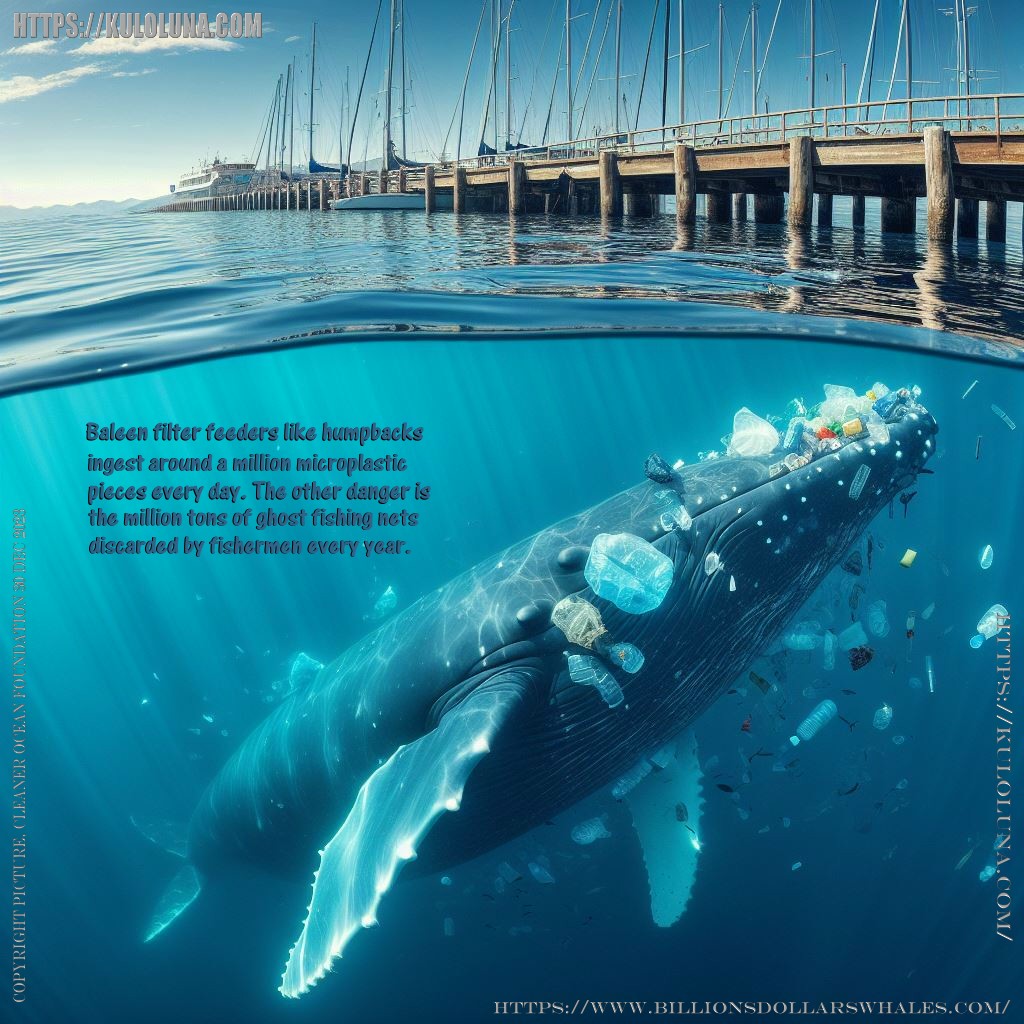
In addition to entanglements, marine biologists also point to the growing problem of ship strikes. Right whales are large, growing up to 50ft in length, and slow moving – making them vulnerable to being hit. In 2008 regulations were introduced requiring large vessels to slow down as they entered ports at certain times in key areas: in winter in the south, where females were calving, and in summer in the north, when right whales are in their feeding grounds. In other cases, shipping lanes were moved.
“However, right whales now seem to be moving out of their historical grounds – most probably in their search for food,” said Bill McLellan, also of the University of North Carolina in Wilmington. Right whales feed on small crustaceans called copepods and some researchers believe that these are moving in response to ocean temperature changes triggered by global warming. “The whales may be following the copepods and that is taking them into waters where they are more likely to be struck by ships,” said McLellan.
More research to understand these population shifts is now needed urgently, say some scientists. In addition, work led by Amy Knowlton of the New England Aquarium, suggests that the recent strengthening of
rope nets and lines has been unnecessary and a return to weaker ropes would save right whale lives. An even better solution, although some way off, would be the development of an electronic means of trapping fish that would eliminate the need for rope lines completely. “There needs to be a paradigm shift in the fishing industry,” Knowlton states in a recent issue of Science.
All agree that action is needed. “Any large mammal whose population is down to the low numbers we are finding is in real trouble,” said Pabst. “So extinction is a very real potential outcome.”
ABOUT
MODERN NETS
Fishing
nets are devices made from fibers woven in a grid-like structure. Some fishing nets are also called
fish traps, for example fyke nets.
Fishing nets are usually meshes formed by knotting a relatively thin thread. Early nets were woven from grasses, flaxes and other fibrous plant material. Later cotton was used. Modern nets are usually made of artificial polyamides like nylon, although nets of organic polyamides such as wool or silk thread were common until recently and are still used.
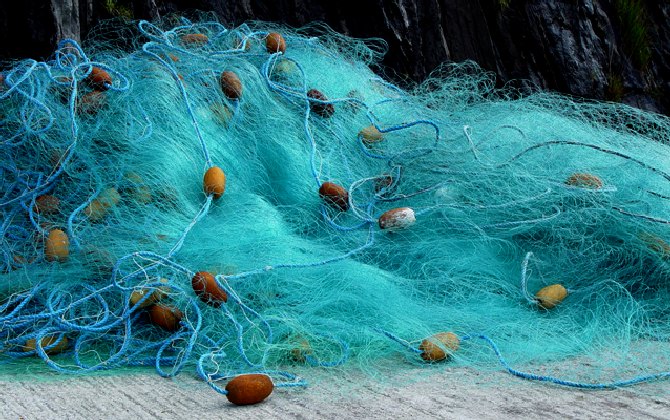
NYLON -
This is a nylon fishing net with float line attached to small plastic floats.
Nylon is a very strong and durable engineering grade plastic
that is also used to make bearings for machinery, printers and
many more applications. It is not the plastic that is at falut,
it is the way we are using it for fishing.
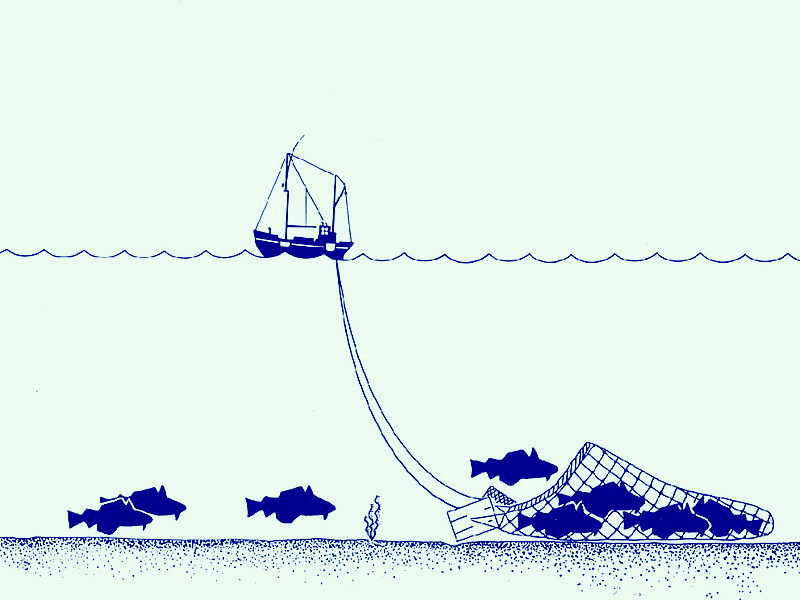
TRAWL
NET - A trawl is a large net, conical in shape, designed to be towed along the sea bottom. The trawl is pulled through the water by one or more boats, called trawlers or draggers. The activity of pulling the trawl through the water is called trawling or dragging. Bottom trawling results in a lot of bycatch and can damage the sea floor. A single pass along the seafloor can remove 5 to 25% of the seabed life.
A 2005 report of the UN Millennium Project, commissioned by UN Secretary-General Kofi Annan, recommended the elimination of bottom trawling on the high seas by 2006 to protect seamounts and other ecologically sensitive habitats. In mid October 2006, US President Bush joined other world leaders calling for a moratorium on deep-sea trawling.
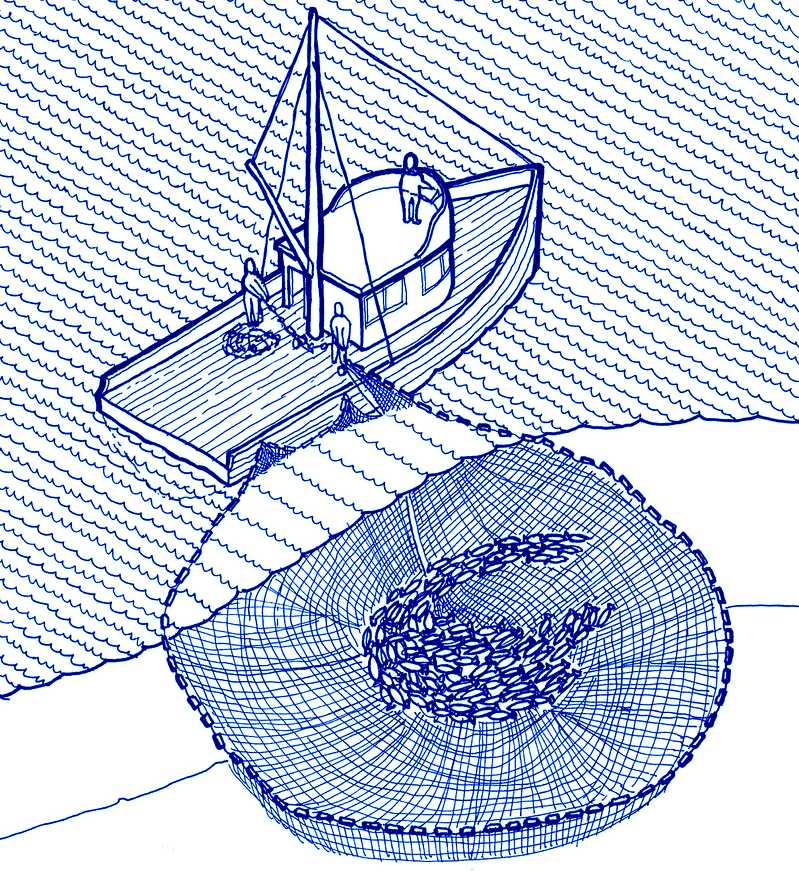
PURSE
SEINE - The purse seine
net is widely used by commercial fishermen, is an evolution of the surround net, which in turn is an evolution of the seine net. A large net is used to surround fish, typically an entire fish school, on all sides. The bottom of the net is then closed by pulling a line arranged like a drawstring used to close the mouth of a purse. This completely traps the fish.
There is a higher chance of bycatch using this fishing method.
NETS
IN HISTORY
In Norse mythology the sea giantess Rán uses a fishing net to trap lost sailors. References to fishing nets can also be found in the New Testament.
Jesus Christ was reputedly a master in the use of fishing nets. The tough, fibrous inner bark of the pawpaw was used by Native Americans and settlers in the Midwest for making ropes and
fishing nets. The archaeological site at León Viejo (1524–1610) has fishing net artifacts including fragments of pottery used as weights for fishing nets.
Fishing nets have not evolved greatly, and many contemporary fishing nets would be recognized for what they are in Neolithic times. However, the fishing lines from which the nets are constructed have hugely evolved. Fossilised fragments of "probably two-ply laid rope of about 7 mm diameter" have been found in one of the caves at Lascaux, dated about 15,000 BC.
Egyptian rope dates back to 4000 to 3500 BC and was generally made of water reed fibers. Other rope in antiquity was made from the fibers of date palms, flax, grass, papyrus, leather, or animal hair. Rope made of hemp fibres was in use in China from about 2800 BC.
Fishing nets have been used widely in the past, including by stone age societies. The oldest known fishing net is the net of Antrea, found with other fishing equipment in the Karelian town of Antrea. The net was made from willow, and dates back to 8300 BC. The remnants of another fishing net dates back to the late Mesolithic, and were found together with sinkers at the bottom of a former sea. Some of the oldest rock carvings at Alta (4200–500 BC) have mysterious images, including intricate patterns of horizontal and vertical lines sometimes explained as fishing nets. American Native Indians on the Columbia River wove seine nets from spruce root fibers or wild grass, again using stones as weights. For floats they used sticks made of cedar which moved in a way which frightened the fish and helped keep them
together. With the help of large canoes, pre-European Maori deployed seine nets which could be over one thousand metres long. The nets were woven from green flax, with stone weights and light wood or gourd floats, and could require hundreds of men to haul.
Fishing nets are well documented in antiquity. They appear in Egyptian
tomb paintings from 3000 BC.
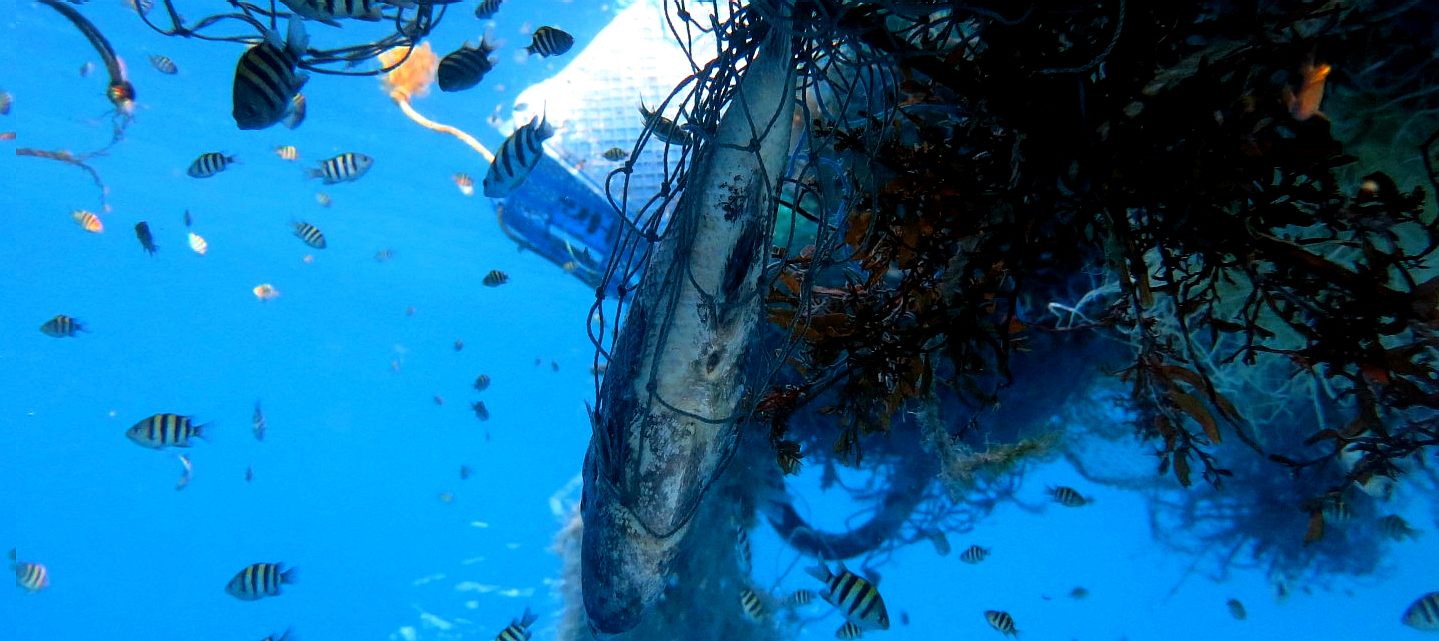
PROBLEM - From 2000 to 2012, the National Marine Fisheries Service reported an average of 11 large whales entangled in ghost nets every year along the US west coast. From 2002 to 2010, 870 nets were recovered in Washington (state) with over 32,000 marine animals trapped inside. Ghost gear is estimated to account for 10% of all marine litter.
According to the SeaDoc Society, each ghost net kills $20,000 worth of Dungeness crab over 10 years. The Virginia Institute of Marine Science calculated that ghost crab pots capture 1.25 million blue crabs each year in the Chesapeake Bay alone.
In May 2016, the Australian Fisheries Management Authority (AFMA) recovered 10 tonnes of abandoned nets within the Australian Exclusive Economic Zone and Torres Strait protected zone perimeters. One protected turtle was rescued.
Some commercial fisherman use gillnets that are suspended in the sea by flotation buoys, such as glass floats, along one edge. In this way they can form a vertical wall hundreds of metres long, where any fish within a certain size range can be caught. If not collected by fishermen these nets can continue to catch fish until the weight of the catch exceeds the buoyancy of the floats. The net then sinks, and the fish are devoured by bottom-dwelling crustaceans and other fish. Then the floats pull the net up again and the cycle continues. Given the high-quality synthetics that are used today, the destruction can continue for a long time.
BYCATCH
Fisheries often use large-scale nets that are indiscriminate and catch whatever comes along; sea turtle,
dolphin, or
shark. Bycatch is a large contributor to sea turtle deaths. Longline, trawl, and gillnet fishing are three types of
fishing with the most sea turtle accidents. Deaths occur often because of drowning, where the
sea turtle was ensnared and could not come up for
air.
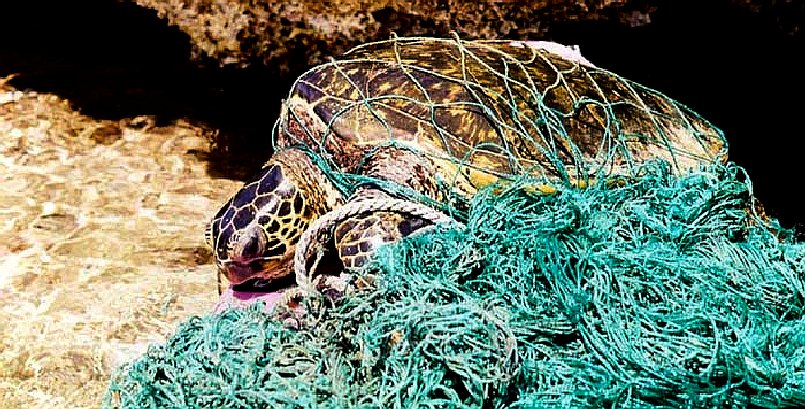
GHOST
NETS - A sea
turtle is ensnared in this fishing net that has been abandoned
by fishermen. Fishing nets are made
of plastic that is very tough and float around killing marine
wildlife and when they finally sink, cause more harm to ocean
ecosystems. Ghost nets are fishing nets that have been left or lost in the ocean by fishermen. These nets, often nearly invisible in the dim light, can be left tangled on a rocky reef or drifting in the open sea. They can entangle fish, dolphins, sea turtles, sharks, dugongs, crocodiles, seabirds, crabs, and other creatures, including the occasional human diver. Acting as designed, the nets restrict movement, causing starvation, laceration and infection, and suffocation in those that need to return to the surface to breathe.

LINKS
& REFERENCE
https://www.theguardian.com/environment/2017/nov/25/whales-right-atlantic-conservation-sea-fishing-extinct
http://www.whoi.edu/
http://news.nationalgeographic.com/news/2015/01/150109-oceans-plastic-sea-trash-science-marine-debris/
http://www.independent.co.uk/environment/plastic-waste-in-ocean-to-increase-tenfold-by-2020-10042613.html
https://en.wikipedia.org/wiki/Marine_debris
http://britishseafishing.co.uk/microplastics-and-ocean-pollution/
https://sustainabledevelopment.un.org/sdg14
http://wef.ch/plasticseconomy
ABS
- BIOMAGNIFICATION
- BP DEEPWATER - CANCER
- CARRIER BAGS
- CLOTHING - COTTON BUDS - DDT - FISHING
NETS
FUKUSHIMA - HEAVY
METALS - MARINE LITTER
- MICROBEADS
- MICRO
PLASTICS - NYLON - OCEAN GYRES
- OCEAN WASTE
PACKAGING - PCBS
-
PET - PLASTIC
- PLASTICS
- POLYCARBONATE
- POLYSTYRENE
- POLYPROPYLENE - POLYTHENE - POPS
PVC - SHOES
- SINGLE USE
- SOUP - STRAWS - WATER
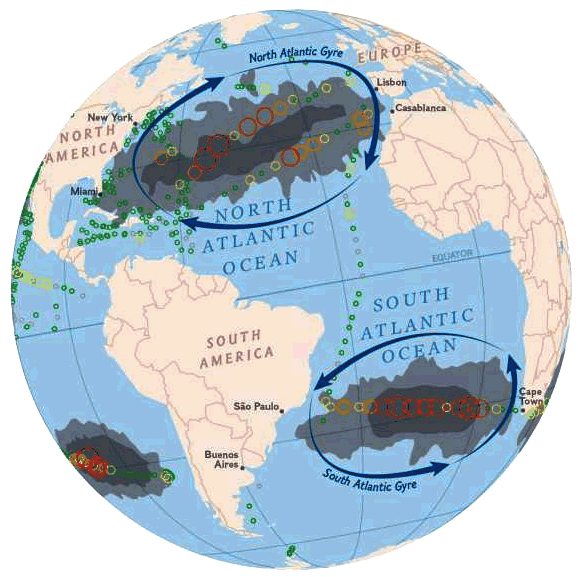
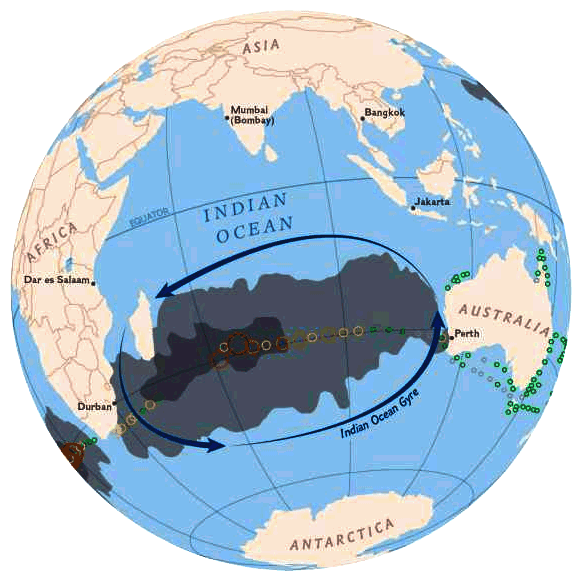
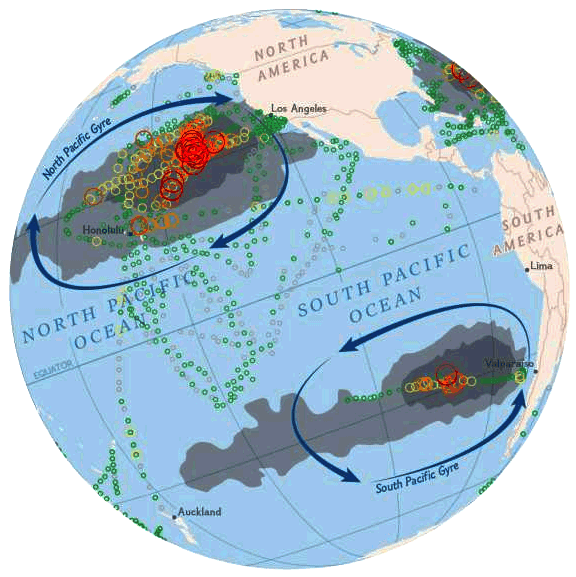
GLOBAL
WASTE PROBLEM - The
above views of planet earth as global views show us the Atlantic, Indian and
Pacific ocean gyres and estimates of plastic waste in
(thousands) numbers of pieces of plastic waste per square kilometer
of sea. The Pacific
Ocean gyres are held to be the worst at the moment.
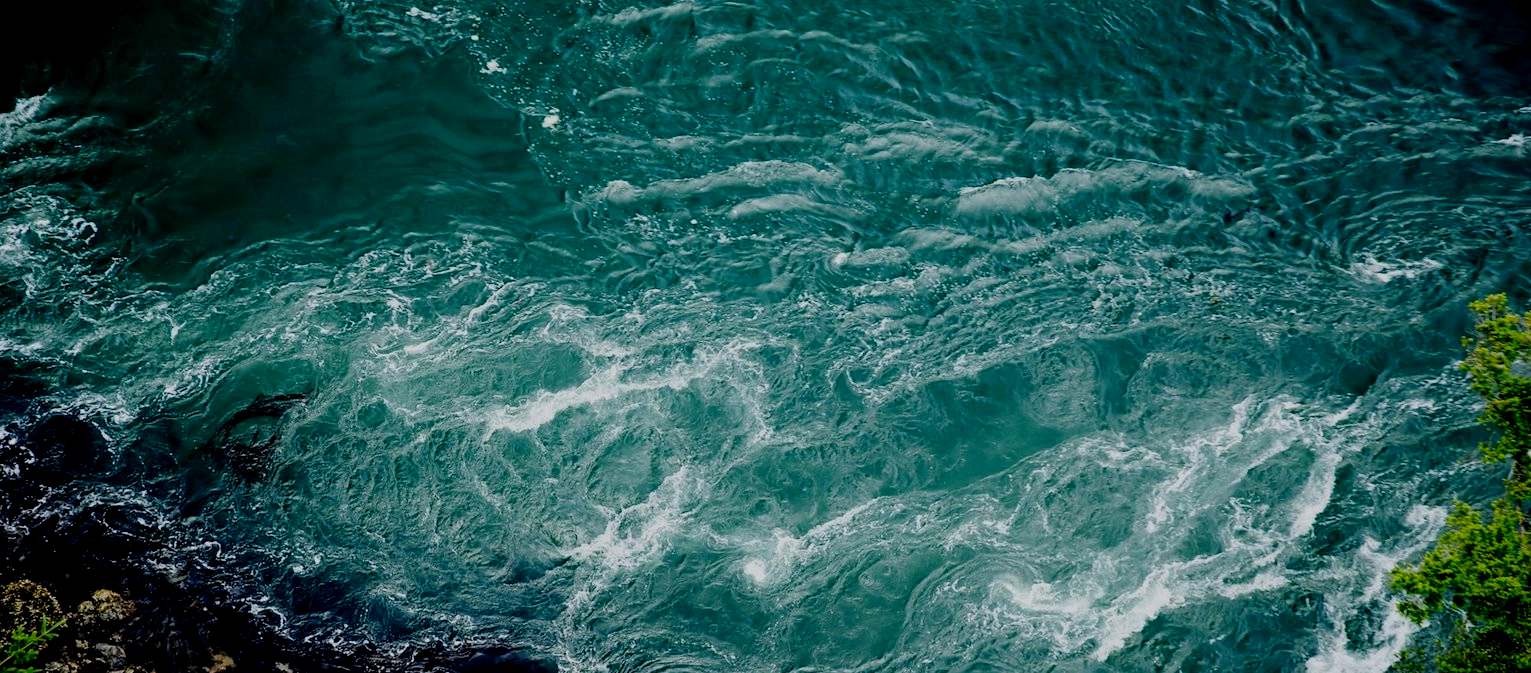
This
website is provided on a free basis as a public information
service. copyright © Cleaner
Oceans Foundation Ltd (COFL) (Company No: 4674774)
December 2024. Solar
Studios, BN271RF, United Kingdom.
COFL
is a charity without share capital.
|










